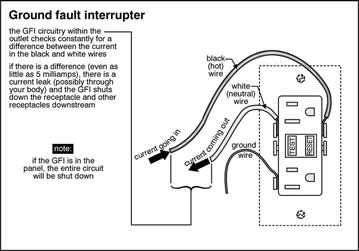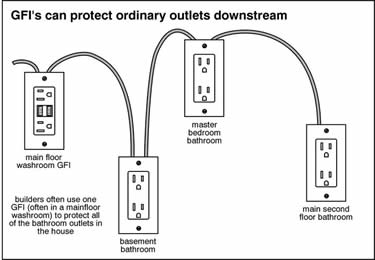|
The outlets with the colored "Test" and "Reset" buttons are specially designed to protect people better than ordinary outlets. GFCIs have been used in houses since the 1970s.
WHY ARE THEY USED?
GFCIs are designed to shut power off if there is a very small leak of electricity (a ground fault) which ordinary outlets wouldn't notice. Normal outlets are shut off by a fuse or breaker if more than 15 amps flow. This prevents fires, but since people can be killed by 1 amp or less, fuses may not protect people from shock. GFCIs shut off power if a leak as small as .005 amp occurs.

HOW DO THEY WORK?
A GFCI detects a leak by comparing how much electricity comes back through the white wire to how much was sent in the black wire. When everything is working correctly, the current flow is the same. If a little electricity is leaking out, it may be going through a ground wire or through part of the house. If this happens, the black wire will have more electricity than the white wire. Electricity, like most people, will follow the path of least resistance. If a person touches a leaky electrical system, they may present a better route to ground for electricity since they may offer very little resistance. Another way of saying this is that the person may be a very good conductor or the person may not be well insulated. The electricity will flow through the person, giving them a shock. Without a GFCI, this can be fatal. With a GFCI, the little leak would be detected and the power would be shut off.
WHERE ARE THEY USED?
In the United States, GFCIs are now required by code for outdoor outlets, bathroom outlets, all kitchen outlets at counter height or on an island, whirlpool outlets, and electrical systems for swimming pools.
CAN THE OUTLET BE GFCI PROTECTED IF THERE IS NO BUTTON?
Yes, IF the circuit breaker back at the panel has a "Test" button, it is a GFCI breaker. This will protect everything on that particular circuit. Any outlets wired downstream of a GFCI outlet are also protected if the GFCI is wired correctly.

CAN THEY BE ADDED TO OLDER HOMES?
Yes, GFCIs can be added to any electrical system. They are more expensive than regular outlets (average $15-$20), but may be viewed as inexpensive insurance. While they do not replace grounding systems exactly, some codes do allow GFCIs in lieu of grounding in some cases. It is safe to say that a circuit protected by a GFCI is better protected than one without.
Illustrations are from the Carson Dunlop Illustrated Home
<< Back to Technical Library |